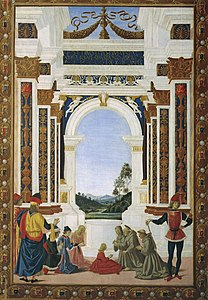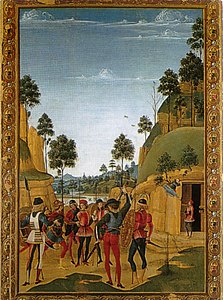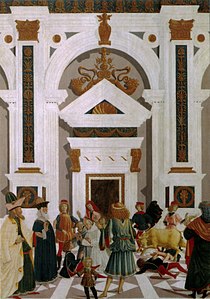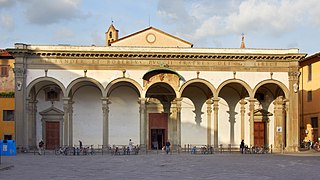
The Basilica della Santissima Annunziata is a Renaissance-style, Catholic minor basilica in Florence, region of Tuscany, Italy. This is considered the mother church of the Servite Order. It is located at the northeastern side of the Piazza Santissima Annunziata near the city center.

Pinturicchio, or Pintoricchio, also known as Benetto di Biagio or Sordicchio, was an Italian Renaissance painter. He acquired his nickname because of his small stature and he used it to sign some of his artworks that were created during the fifteenth and sixteenth centuries.

Pietro Perugino, an Italian Renaissance painter of the Umbrian school, developed some of the qualities that found classic expression in the High Renaissance. Raphael became his most famous pupil.

Fiorenzo di Lorenzo was an Italian painter, of the Umbrian school. He lived and worked at Perugia, where most of his authentic works are still preserved in the Galleria Nazionale dell'Umbria.

Spello is an ancient town and comune (township) of Italy, in the province of Perugia in eastern-central Umbria, on the lower southern flank of Monte Subasio. It is 6 km (4 mi) NNW of Foligno and 10 km (6 mi) SSE of Assisi. It is one of I Borghi più belli d'Italia.

The Marriage of the Virgin is a painting by the Italian Renaissance master Perugino, although it is now sometimes attributed to his pupil Lo Spagna. It depicts the marriage between Joseph and Mary, and is now in the Musée des Beaux-Arts of Caen, France. Initially commissioned to Pinturicchio for the recently completed cathedral of Perugia, Perugino took over the commission and finished the work around 1500–1504, probably after several periods of stasis.

The Basilica della Santissima Annunziata del Vastato is the Catholic cathedral of Genoa, northern Italy; its decoration employed the major baroque studios and artists in Genoa in the 17th century.
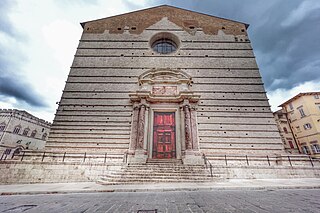
Perugia Cathedral is a Roman Catholic cathedral in Perugia, Umbria, central Italy, dedicated to Saint Lawrence. Formerly the seat of the bishops and archbishops of Perugia, it has been since 1986 the archiepiscopal seat of the Archdiocese of Perugia-Città della Pieve.
The decade of the 1480s in art involved some significant events.
The decade of the 1450s in art involved many significant events, especially in sculpture.

Bartolomeo Caporali was an Italian painter and miniaturist in Perugia, Umbria during the early Renaissance period. His style was influenced by Umbrian artists Gozzoli and Boccati, two of his first mentors, and continued to evolve as younger Umbrian artists came onto the scene, such as Fiorenzo di Lorenzo, Perugino and Pinturicchio. Although primarily a painter, he is also known for executing missals, restoration work, gilding, armorials, banners and celebratory decorations, which speaks to his decorative, detail-oriented artistic style. His most famous works include Madonna and Saints (1487) for the church of Santa Maria Maddalena at Castiglione del Lago, The Virgin and Child Between Two Praying Angels, and his Adoration of the Shepherds.
Events from the year 1522 in art.

The Bufalini Chapel is a side chapel of the church of Santa Maria in Aracoeli, Rome, Italy. The first chapel on the right after the entrance, it houses a cycle of frescoes executed c. 1484-1486 by Pinturicchio depicting the life of the Franciscan friar St. Bernardino of Siena, sainted in 1450.

The Crucifixion between Sts. Jerome and Christopher is a painting by the Italian Renaissance master Pinturicchio, painted around 1475 and housed in the Borghese Gallery of Rome, Italy.

The Girdle of Thomas, Virgin's Girdle, Holy Belt, or Sacra Cintola in modern Italian, is a Christian relic in the form of a "girdle" or knotted textile cord used as a belt, that according to a medieval legend was dropped by the Virgin Mary from the sky to Saint Thomas the Apostle at or around the time of the Assumption of Mary to Heaven. The supposed original girdle is a relic belonging to Prato Cathedral in Tuscany, Italy and its veneration has been regarded as especially helpful for pregnant women. The story was frequently depicted in the art of Florence and the whole of Tuscany, and the keeping and display of the relic at Prato generated commissions for several important artists of the early Italian Renaissance. The Prato relic has outlasted several rivals in Catholic hands, and is the Catholic equivalent of the various relics held by Eastern Christianity: the Cincture of the Theotokos of the Eastern Orthodox Church and the Holy Girdle of the Syriac Orthodox Church.
Gerino da Pistoia, also Gerino di Antonio Gerini, (1480–1529) was an Italian painter and designer of the Renaissance.

The Scuola del Santo or Scoletta was the headquarters of the Archconfraternity of St Anthony of Padua. It overhangs the churchyard of Basilica of Saint Anthony of Padua, next door to the St. George's Oratory.
